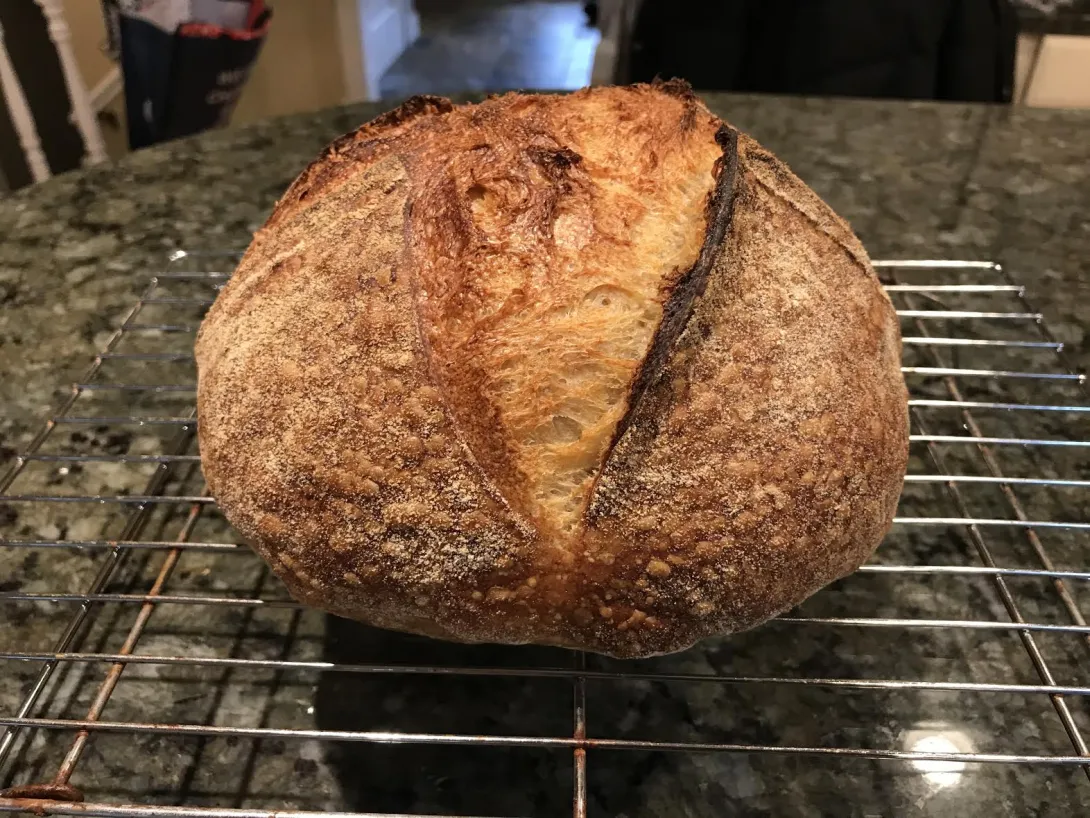

So after taking a break from sourdough for a while and working on improving my regular French bread skills, I figured that I was ready to tackle a basic sourdough again and avoid the gummy crumb that's plagued me since I've started. I used Maurizio Leo's "Beginner Sourdough Recipe" (https://www.theperfectloaf.com/beginners-sourdough-bread/) but ended up adding one more stretch-and-fold (I accidently added 15g of extra water so the dough felt slack) and extending the bulk ferment by 45 minutes since the internal dough temperature was much cooler than his. I baked the dough exactly as instructed and took it out when the internal temperature hit 205 degrees. As you can see, the scoring is a bit sloppy but I still think the oven spring looks pretty good. I broke open the loaf, praying that I would get a nice, solid, creamy crumb, and...

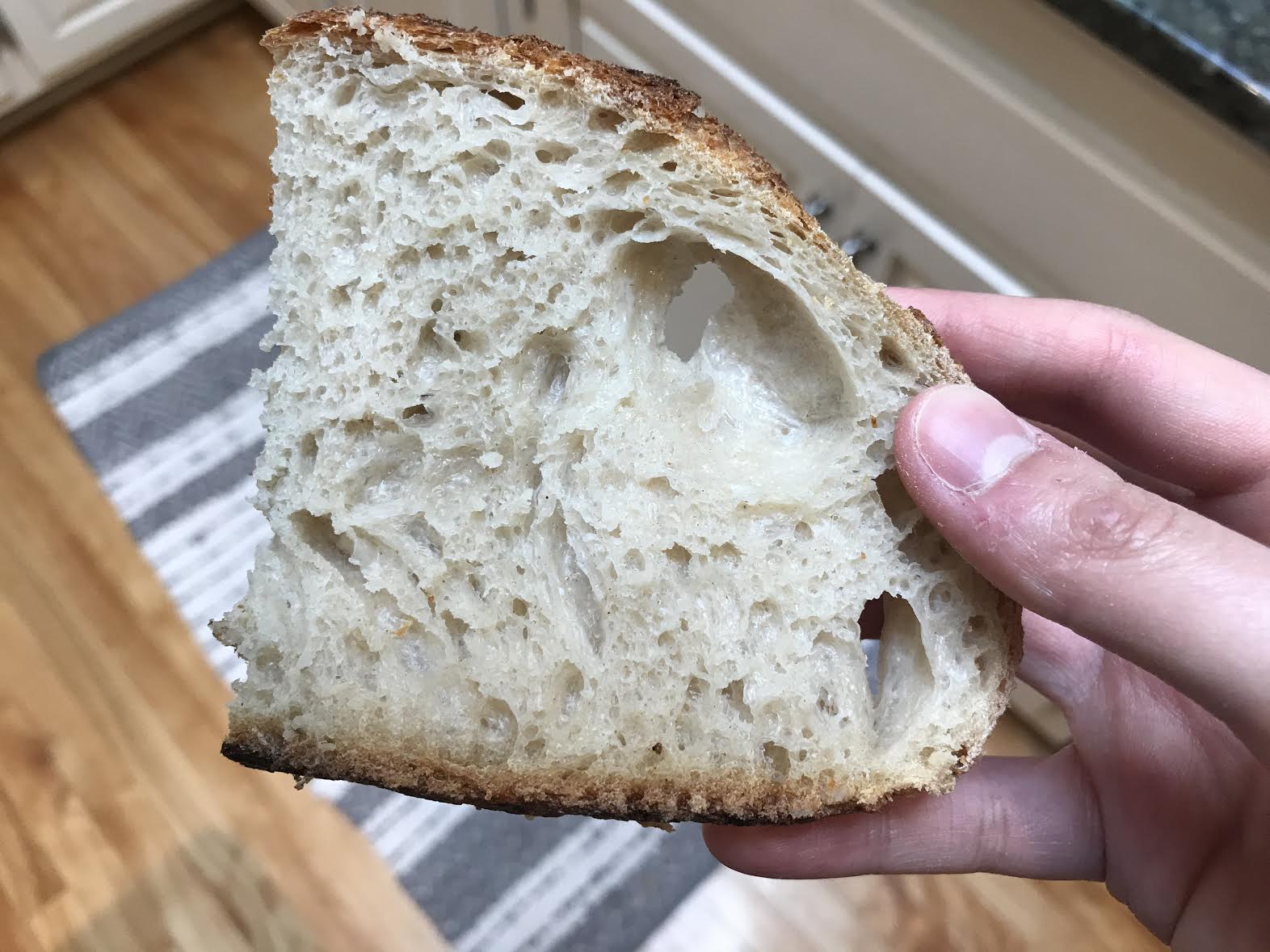
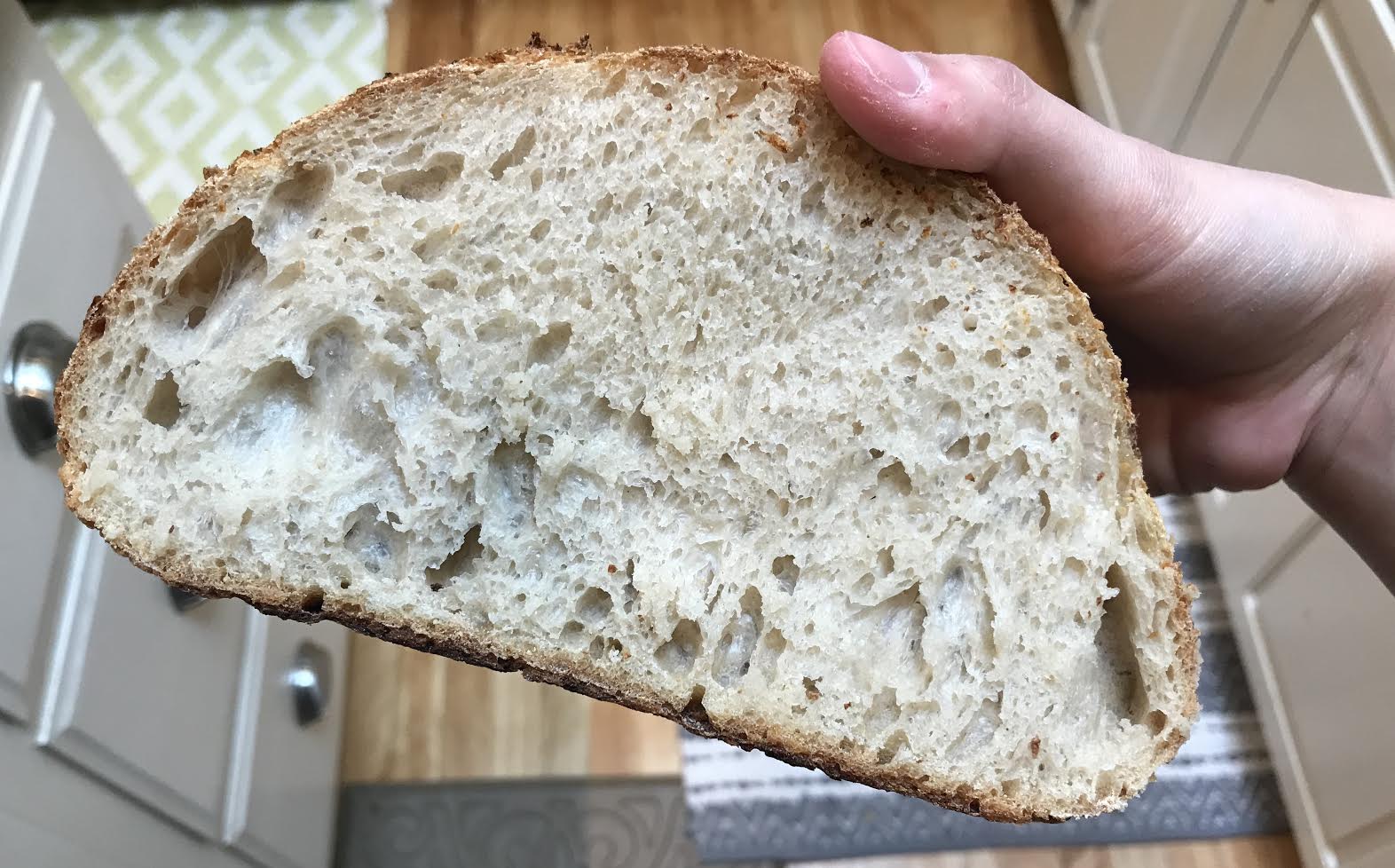
No luck. Still heavy and rubbery with an off-taste. I'm completely baffled at this point. The exterior does not indicate any under or overproofing and crumb seems normal in some places and abnormal in other places. I had thought previously that maybe the gumminess was because it was underbaked and yet the internal temperature was 211 degrees when I pulled it out after the 50 minutes. The tight crumb in the center definitely raises an eyebrow but, I mean, I've bought artisan loaves with crumbs that look like that and their texture is fine. And all in all, I don't think the crumb differs toooooo much from Maurizio's loaf asides from his looking much less wet and shiny:

None of my non-sourdough artisan loaves have this problem...so what on Earth is going on!? Has anyone else had this problem? Any advice at all would be appreciated.
Troll, I experienced something similar when using high gluten flour. Have you experimented with different types of flour?
The boule is beautiful...
Danny
Thanks for the reply! I actually used King Arthur All Purpose rather than the bread flour called for in the recipe since its 11.7% protein basically makes it bread flour anyway. Plus I noticed that the bread flour Maurizio uses in other recipes (like his "Best Sourdough" recipe) is around 11.5% protein. I pretty much only use KA AP for any recipes that call for bread flour and then use regular bread flour for ones that call for high gluten flour. However, I know that a lot of European breads use even softer flours that range from 9-11% so maybe that's what I need to look into? I guess it would be good practice in dealing with slack doughs without actually increasing the hydration. ¯\_(ツ)_/¯
Definitely not the flour, then. I know that crumb and also don’t like it.
If other attempts don’t solve it, you could try baking a bread with commercial yeast to see if that makes a difference. If that solves it, focus on the starter.
Yeah, I think I might just double down again on improving my commercially yeasted artisan loaves. Once I'm happy with consistent results, I'll probably venture back into sourdough. It seems I still have much to learn in the strange world of yeast, lol.
If your commercially yeasted breads are not gummy, then you would need to look closely at your starter and methods.
Maurizio’s crumb, as you said doesn’t look that great to me. Maybe consider another formula.
Maurizio’s Crumb below.
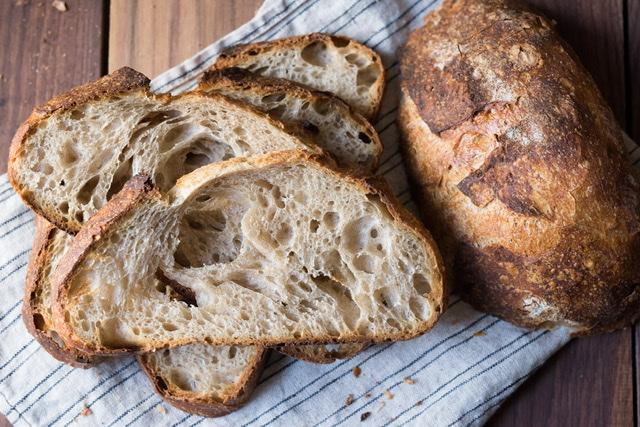
If you want to try another formula, Kristen’s Basic Open Crumb SD had great results from all bakers that participated in a recent Community Bake. Here is the link.
I actually have made that recipe quite a few times in the past with the same results (although a link for the recipe is useful, thanks!). Granted, I have improved a lot at shaping, judging fermentation, and a whole bunch of other skills since I last tried it so its probably time that I give it another shot. I think if any factor is off in my methods it's probably underproofing or overproofing...just not sure which one yet...
AFT, if crumb is too gummy/moist, you generally/usually have two options: 1) lower the hydration of the formula just a tad, or 2) bake longer at a lower temp to cook off more moisture before the crust hardens, and darkens. These are common tweaks/adjustments made for local conditions: your flour, your starter, and your oven charactertisics.
Your crust, especially on the bottom, does look a little dark in spots. So I'd lean to a longer, but lower temp bake, as a starting suggestion.
there _might_ be a folding/degassing (the one right before shaping) issue that if addressed might give a more consistent hole pattern in the crust. but that is probably secondary to your moisture/gumminess fix.
beautiful oven rise. Congrats on that.
Longer lower bake...that makes sense! I had just kinda assumed that so long as the ideal internal temperature was reached it would for sure guarantee a proper texture but I guess hot water can reach 205 degrees too, huh? The original recipe called for a 500 degree preheat, 20 minutes at 475 degrees with steam, and 30 minutes at 450 without steam; should I prolong both halfs or only one of them? I know that the first 10-20 minutes has gotta have a high temperature in order to get good oven spring so I'm wondering if maybe I should only alter the last 30 minutes of baking. Or maybe it doesn't matter?
Hey, I suddenly started having the same issue when we moved to a new house with an oven that I'm now realizing runs very hot. So I've been pulling the loaves out when they get fully browned, but they cooked too quick so there's still too much moisture inside. Are you also finding that the bread can't seem to maintain it's crust? My crusts are going soft.
I definitely think a longer, slower bake is called for.
Hey, I suddenly started having the same issue when we moved to a new house with an oven that I'm now realizing runs very hot. So I've been pulling the loaves out when they get fully browned, but they cooked too quick so there's still too much moisture inside. Are you also finding that the bread can't seem to maintain it's crust? My crusts are going soft.
I definitely think a longer, slower bake is called for.
Hi fellow bakers,
I'm having the same issue with you both so following to see if there's a solution. I usually bake country SD with 15% whole wheat, and a 85% of a medium-high bread flour (11.5-12% protein); at 80% hydration. I have a small 2nd hand deck oven (with no steam injection) that works really well at retaining and radiating the heat so my baking tempt is usually much lower than when I bake in the small convectional oven.
I also got the gummy crumb and a clear taste of sourness (not the good smooth yogurt lactic acid) upfront when taking the first bite. I look it up and there's 2 common explanations: 1 is improper bulk fermentation where the levain does not aerate the dough properly (extending the cold retard won't help here) and 2 is improper baking temperature. Last night I make 4 more loaves trying to fix the issue, and I ensure that the bulk is proper: lots of sign of fermentation, good tension, the dough increased by nearly 50% when I divide and shape; I let the dough rest some more after shape to achieve double increase in size (because it's a dough with mostly bread flour; I usually not let dough with lots of whole wheat went that far) before going to cold retard at 4-5oC. Everything seems fine. The crumb is the one you can see in the picture above.
Yet it is still gummy. I don't think this is the custardy or moist crumb people are talking about high hydration dough. Now I do think that my issues lies in the deck oven, it can be too hot.
Usually guidance on recipes is you preheat to 250oC and bake with steam at around 240-250oC. This is too hot for a deck oven, it will form the crust in no time. I usually tried 230oC top heat and 210oC bot heat. Today's bake, I checked internal tempt and it reaches 98-99oC, seems fine. Now there's a baker I follow on instagram named Campbell (https://www.instagram.com/campbell2664/). He bakes in a Rofco with baking stones and his method is to preheat at 250-270oC, right after loading he will turn the oven tempt down to 200oC to bake for 20 minutes with steam. He said the baking stones will retains much heat during preheat period and will bake the dough properly; and if he leaves the tempt at 230-250oC, it will spring up really high and crust forms early. This is one technique I really want to try and see if it solves the gummy crumb issue.
I'll let you know the update. Please let me know if you find a solution too.
up to snuff. The unwanted sour notes might indicate a bigger feeding before baking with the culture. More on the starter feeding amounts and timing, temp etc. can help pinpoint a problem.
Hi Mini,
I'm maintaining a very active 100% hydration all white starter that raise 5x overnight at 25oC (feeding overnight 1:10:10). I fed it 2-3 times a day and always feed at peek. I do realise I got very unwanted sour note with my previous starter (mix of rye and white) - the bulk back then usually prolong for 6 hours even at a warm dough tempt of 25-26oC. This could definitely be an issue. But I'm more on the issue of the oven now, I think it brown my crust too early.
tends to give a more sour tasting bread. If you split it up into two or more builds for the same amount of end starter, you should have a milder tasting bread.
That's a good point, Mini. Thank you.
I live in the tropics (25-27 degree room tempt) so even at 1:10:10 feeding overnight, it would peak after I wake up (in 8 hours) anyway. I will try 2 builds: 1:10:10 overnight (so that it won't collapse when I wake up) then discard and feed 1:2:2 again in the morning for the levain to see if it impacts the sourness. I want the mildy lactic acid so I don't want to feed it with ice cold water even though that will slow the fermentation down.
like a 1:5:5 and then feed after it falls without discarding. You can also reduce the water to slow down fermentation and add it back later. Like 1:3:5 assigning the two parts missing water into the dough later. That way you avoid the one to tten ratio feeding.
Mini, I just wonder if letting the starter fall/past peak will increase the accumulated acidity and make the levain sourer?
but what I mean is if you prepare a1:5 overnight and it falls by morning, you haven't lost much power because it will rise again, there is enough food for a second peak. Feed that first peak if you can but a second feeding will be shorter but with less total acid. Just try it.
Oh, and it is typical that sourdough breads grow more sour as they stand after the bake. I haven't yet heard of a loaf getting less sour as it ages.
go up to 210° just to make sure it's baked thru. Saw that attemp. Ok good. What I see in the crumb...and it might help to look at a slice upside down.. it looks like the banneton is insulating the rising loaf from the surrounding warmer air temperature. Can this be? The top (and later the bottom of the loaf) is warm and rising more than the side in the banneton. Solution might be to insulate the top of the rising loaf to keep all the dough at the same temp. Avoid letting the banneton sit in the sun or in a warm place.
Never thought to look at the slice upside down! While the dough was cold retarded, I did let it acclimate at room temperature for about an hour on baking day since my fridge was a lot colder than Maurizio's. I put a couche over the top of the banneton but I suppose a banneton is thicker than a couche so it's possible that yeah, the top warmed up faster than the sides. I'll experiment with just increasing the fridge temperature or leaving it longer in the fridge to see if that helps.
Sure you are probably already aware, but there’s more to flour than just the protein level. In particular for SD, the mineral (‘ash’) content is also pretty important - which is linked to the growing conditions and extraction level.
According to an article by Debra Wink, this is because the minerals can create a natural buffer system that allows the LAB to create more acid (i.e. grow more) before affecting the pH of the dough to the extent that it inhibits their metabolism.
When I first switched from using commercial yeast, I didn’t understand the importance of the ash content and couldn’t understand why higher protein flours weren’t giving me a ‘better’ loaf. Once I switched away from imported Canadian flour to a lower protein, higher mineral one from here in the U.K. the texture and flavour of my bread improved noticeably. And now I come to think of it, it did used to be a bit gummy before, too.
Good luck and stick with it!
Troll, I’m not sure you missed the mark with this bake. Check out your crumb and compare it to Maurizio’s.
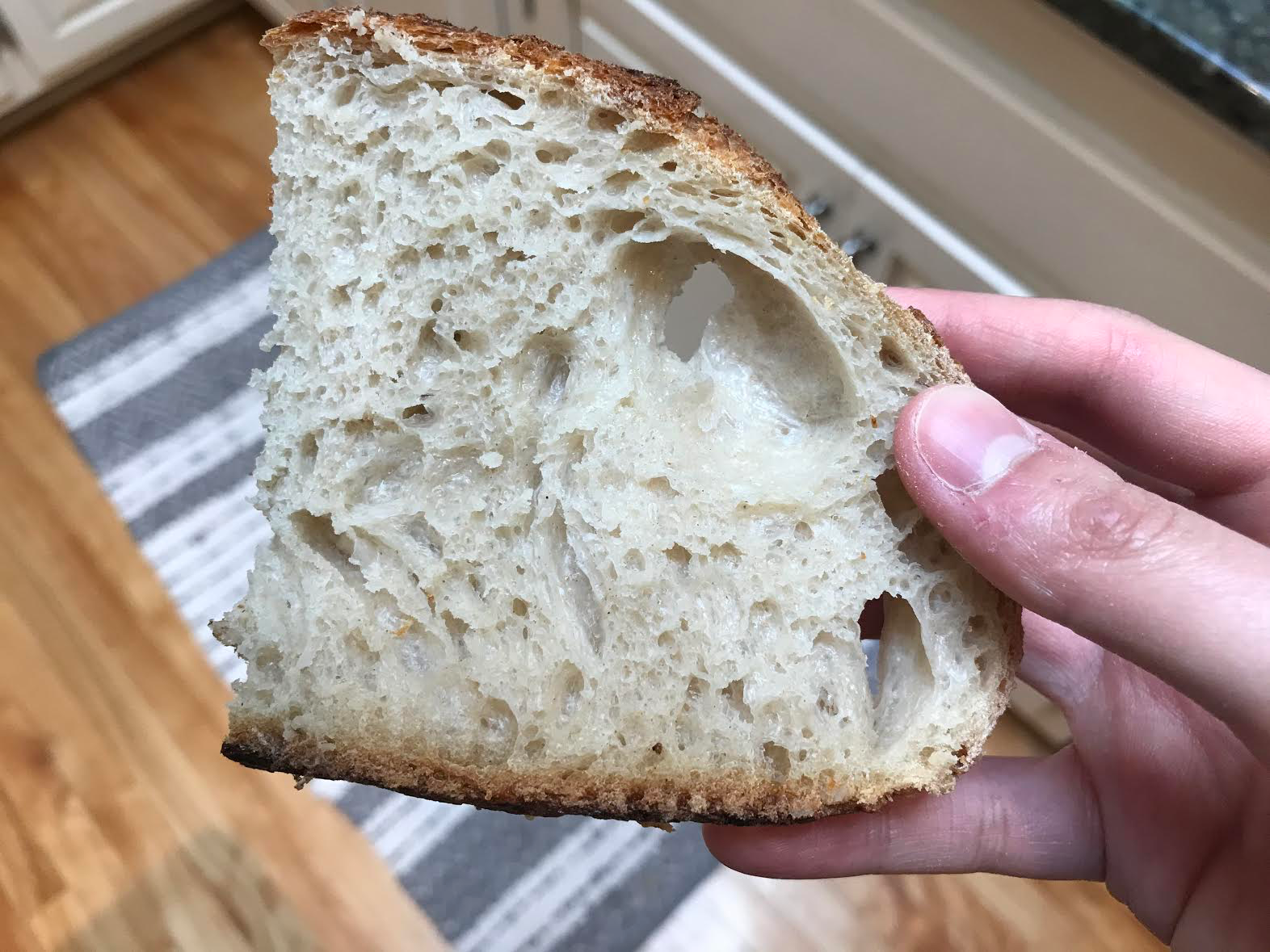
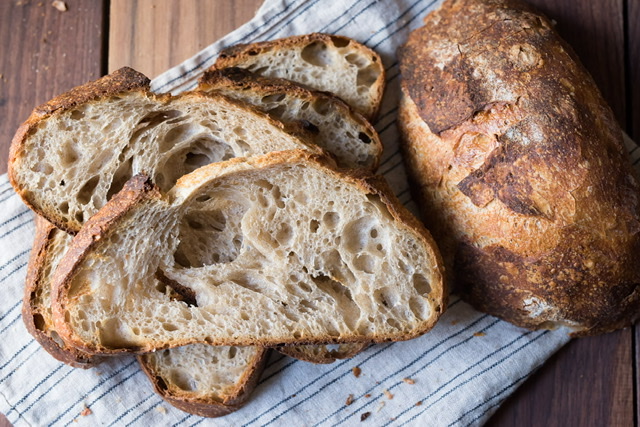
Maurizio’s instructions and corresponding images are outstanding, but not something I’d recommend as a first choice to a new sd baker. His crumb is not that much different from yours when you compare them closely.
I recommend you giveKristen’s Basic Open Crumb SD another try.
One more point I notice is when I get gummy crumb, a clear sign is the crust does not stay crispy for long, guess this is because of the water evaporation from inside. Plus, the bread gets more sour with time - My wild guess is the free water are still in the crumb which makes the bread sourer faster?
So in the end did 'cook low and slow' in first cook yield satisfactory results? Only issue I have with my bread now is the guminess of the dough!
Surely you mean crumb. What in all quarantined and limited kitchens do you mean? :)
My mind pictures a stiff ball of latex. .... Hey! My water is wet!
Be ready to cough up lots of detail or admit to a bad spelling checker.
put the whip down! no latex here.
I just meant i get the gelatinous sheen that the OP was writing about... I made a loaf today which was bouncy and chewy, in the good way mind, dissolves beautifully and was very light. Crust was wafer thin and crisp with a great oven spring... but there was still the sheen. OP came to the conclusion it was a a facet of SD, they seemed to do extensive testing so I am inclined to agree with them!
Hi Troll and everyone. I'm new here and relatively new to baking bread. I started my sourdough adventure in mid-March, after I began working at home 4 out of 5 days. When I started my sourdough baking, i was immediately drawn to Maurizio's website. Beautifully guided, with easy to follow recipes. As an added bonus, lots of sciencey explanations.
My first boule was pretty dense and had very little rise. After some research, I figured out that I had not used my starter at its peak when making my levain. My second batch, Maurizio's simple weekday recipe, came out with lovely spring and a beautiful crust. The crumb, however, was much like yours, Troll, and others here: it had a gummy feel to it.
Around 3am the next day, I realized that Maurizio was baking at over 5,280 feet. I was baking at 270 feet, almost an exact 5,000 foot difference in elevation. He also was baking in a very arid climate, with average humidity of 30%. I was baking in a very humid climate, with average humidity of 70 to 80+%. So, I reduced my hydration by 5 percentage points.
The result was less gumminess, but almost a slight dryness and hardness to the crumb.
After reading everyone's responses here, I did a little research based on something that caught my eye: baking at a lower temperature for longer periods. I wondered, would his altitude versus my altitude alter the temperature and time at which he would need to bake?
King Arthur Flour's website was useful in answering my question. As to temperature, altitudes over 5,000 feet generally require a 15 to 25 degree (F) increase over lower-altitude temperatures. This is because leavening happens quicker in the lower air pressure of a high altitude and evaporation happens much quicker, too. So you compensate by setting the crust quicker by raising the temperature. As to length of bake, you decrease the baking time by 5 to 8 minutes per 30 minutes of baking. King Arthur simply says that baked goods bake quicker at higher altitudes. My guess is because of the aforementioned reasons: leavening happens faster as does evaporation.
Unfortunately, I just completed my weekly baking and my starters are in the fridge for their weekly hibernation. This weekend, I will adjust my baking using the suggestion of King Arthur, in reverse, since I'm baking at a lower altitude than Maurizio. I will decrease my temperature and I will increase the length of my bake. I'll be glad to report back my results, if you would like.
I am excited to learn more about this community! Y'all sound like my kind of people. lol
Hi I am having the same issues after 20 over loaf of breads i baked. I always thought is my old oven temp too low with 230C only so i prolong the cover time from 20 to 25 minutes but did not show any significant different. Then i suspect is my too high percentage of water so i reduce 5% of water still no significant different. So the only thing i never try is this. Please update on this. Thanks!
a picture bakes a thousand words. ..or starts a thousand Q's.
I normally bake the sourdough bread with clay pot after preheat for 45 min under 230C then for 20-25min covered and 210C after open cover.
So this time i tried with 200C preheated for 30min and baked for 45 min covered and 200C for 15 min open. Then the texture look no significant difference. ?
Does the knife become sticky when cutting the loaf? What hydration is the bread and how strong is the gluten?
Sorry i should say it is rubbery not gummy.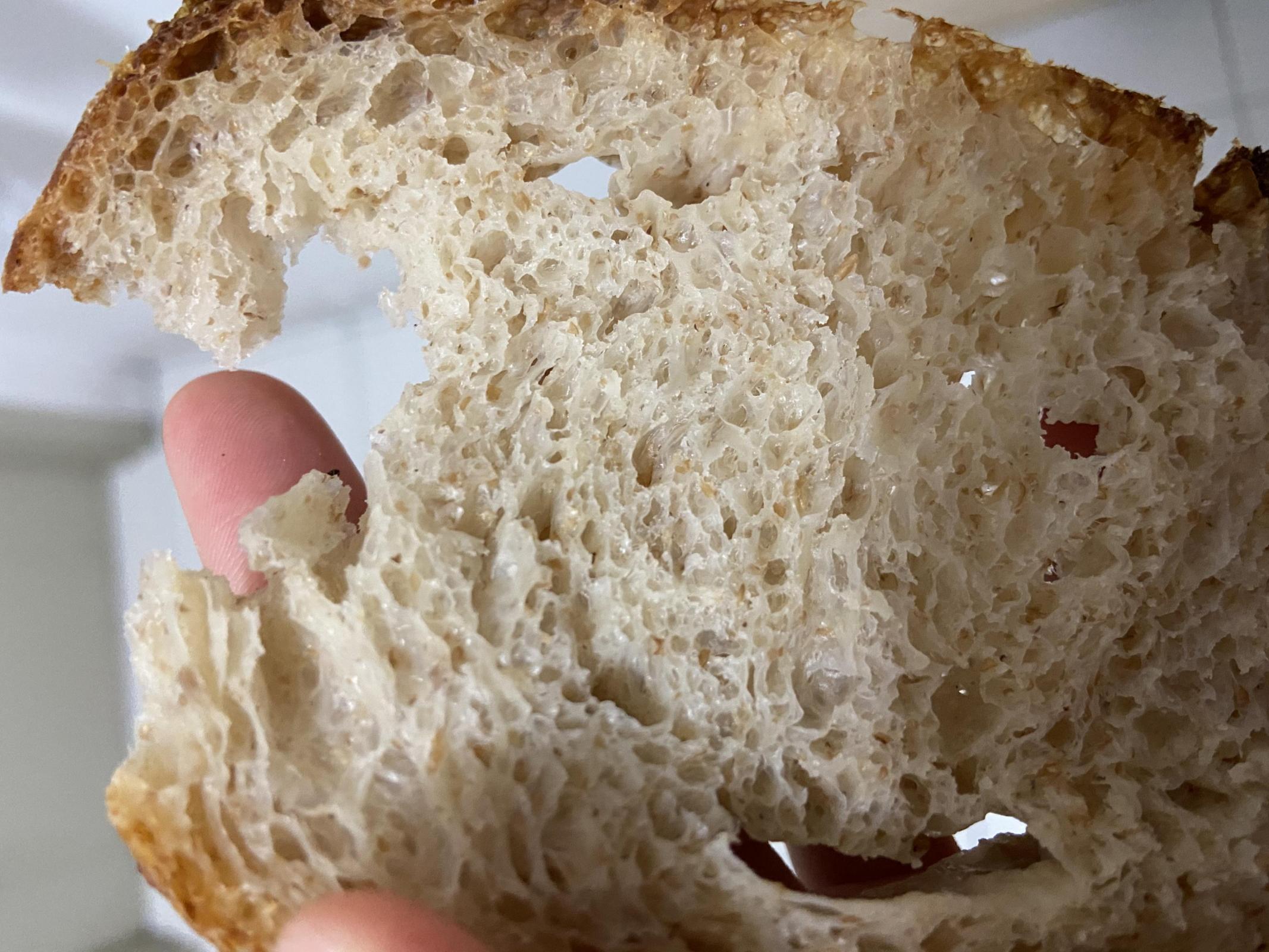 Hydration is 70% only. I used to baked at 75%. Both get same result .. rubbery.
Hydration is 70% only. I used to baked at 75%. Both get same result .. rubbery.
Even at 70% hydration one can get that typical rubbery/chewy crumb. Some like it! If you wish for a more soft crumb then try using 11-13% protein flour or a mix of bread and AP flour. Try lowering the hydration to 65-68% and don't do an extended autolyse or a very long ferment. Another option is to put a little oil in the dough. This will make a softer crumb.
I don't think it's to do with the baking but rather the handling of the dough.
I am using normal bread flour not expensive type so I'm guessing it should be around 11% only. And my recipe is 80% bread flour with 20% wheat flour.
Thanks for your advice next i shall try on lowering the hydration and reduce the autolyse and fermentation and cold retard time.
I might try the oil, and see if that makes a difference. I also suffer from a rubbery/sticky crumb. Once I've had a soft crumb, and I'm not sure if it was the hydration (50%) or being over proofed (200+ gram of starter for a 400 some gram loaf and the instructions said proof 2 hrs, shape and leave over night!) But even with the lack of oven rise, it was soft and delicious
If you can get the BRM Artisan Bread Flour, please do. It should turn out similar. Also, he put in a couple of other flours in the mix.
Each flour company uses a different blend of flours and the approach may be slightly different for each.
You mentioned that you are using KA AP Flour. That is a great flour as well. However, may I suggest a different approach: https://www.youtube.com/watch?v=KkulM98briI&t=290s&ab_channel=ABeautifulPlate or https://www.youtube.com/watch?v=x-hIRJaZIv8&t=298s&ab_channel=KingArthurBakingCompany
The issue here is using the no knead method vs. the knead/fold method. Maurizio's approach in this recipe is somewhere in the middle. I believe that KA AP is a blend of winter wheat with some spring wheat for strength. If you are going to use this flour, may I suggest the hand knead for 5-10 min/4 folds/cold retard technique.
Try it out, you will be pleased with the result.
This is my first sourdough bread:
I followed the recipe Everyday Sourdough from the book Artisan Sourdough Made Simple by Emilie Raffa:
I used Doves Farm Organic Strong White Bread Flour, which is probably one of the best flours I can easily find here in Ireland. My started is about 2 months old, fed with the same flour and used at it's peak.
It was baked for 20 minutes covered + 30 minutes uncovered + 10 minutes on the oven rack at 230°C (450°F). It cooled down for about 3 long hours.
The result was a tasty loaf which was devoured in a matter of a couple of hours. But I can relate the issue described in this post: a gummy crumb.
While looking for ways to improve it, I came across this thread. I don't have solutions yet, but I will try to follow some of the advices I've seen here, like:
Let's see the results in the next few days.
I don't think so. That's a lovely loaf! You do know you can share loaves just because they came out well and you're proud of them. :) We share your enthusiasm! Only two months? Very Good!
The bread knife looks immaculate.
Complete ballpark, I don't know what I'm talking about, but perhaps try letting it cool for 12+ hours before slicing, depending on the recipe. I know it's hard, but perhaps worth a try... In a bread cloche or something similar, bread bag maybe.
I've had some gumminess using King Arthur flour myself.
Here is a thread from here...
https://www.thefreshloaf.com/node/48895/gummy-dense-centre-sourdough-boule